Overview
The article titled “10 Examples of Quality Improvement in Nursing for Better Patient Care” delves into various initiatives aimed at enhancing nursing practices to elevate patient care standards. It underscores specific examples from esteemed organizations such as:
- CareSet
- Florida Department of Health
- DaVita Dialysis Clinics
These case studies illustrate how data-driven strategies, the integration of patient feedback, and the development of personalized care plans contribute to improved outcomes and heightened safety within healthcare environments.
Introduction
In the ever-evolving landscape of healthcare, the integration of data-driven strategies and quality improvement initiatives is transforming patient care across various institutions. By leveraging comprehensive Medicare data to enhance treatment decisions at CareSet and pioneering innovative nursing practices in Florida, hospitals and health organizations are elevating standards and outcomes. As they embrace technology, interdisciplinary collaboration, and personalized care, these efforts not only address immediate challenges but also lay the groundwork for a future where patient safety and satisfaction take center stage.
This article delves into impactful initiatives undertaken by notable healthcare entities, showcasing how their commitment to quality improvement is reshaping the patient experience and driving meaningful change in the industry.
CareSet: Transforming Patient Care with Comprehensive Medicare Data Insights
CareSet leverages its extensive database of Medicare claims information to deliver insights that significantly enhance healthcare quality. By analyzing over $1.1 trillion in annual claims, the company identifies critical treatment trends and service deficiencies, empowering healthcare professionals to make informed decisions that lead to improved outcomes for patients. Notably, the integration of remote health monitoring has been shown to reduce hospital admissions for individuals with chronic conditions by 25%, highlighting the transformative potential of data-driven strategies in healthcare.
CareSet’s comprehensive Medicare data solutions equip healthcare strategies with insights derived from over 62 million beneficiaries and 6 million providers. This dedication to transparency and data leadership enables stakeholders, including pharmaceutical and biotech companies, to adeptly navigate the complexities of the healthcare landscape. As value-driven treatment contributes to a 7% reduction in healthcare inequalities, the insights gained from Medicare claims data are fundamental to fostering equitable treatment for all individuals.
In a recent case study centered on oncology treatment options, CareSet illustrated how its data solutions can enhance physician engagement concerning treatment alternatives like Qinlock for Gastrointestinal Stromal Tumor (GIST). Carter Bakkum remarked, “The total National Medicare Advantage penetration as of March 2021 is expected to grow in the coming years,” emphasizing the increasing importance of Medicare data analytics. By focusing on actionable insights, CareSet provides an example of quality improvement in nursing, addressing immediate data needs while supporting long-term strategic development for its partners and ultimately elevating the standard of care provided to patients. To discover how CareSet can empower your healthcare strategies, let’s initiate a conversation.
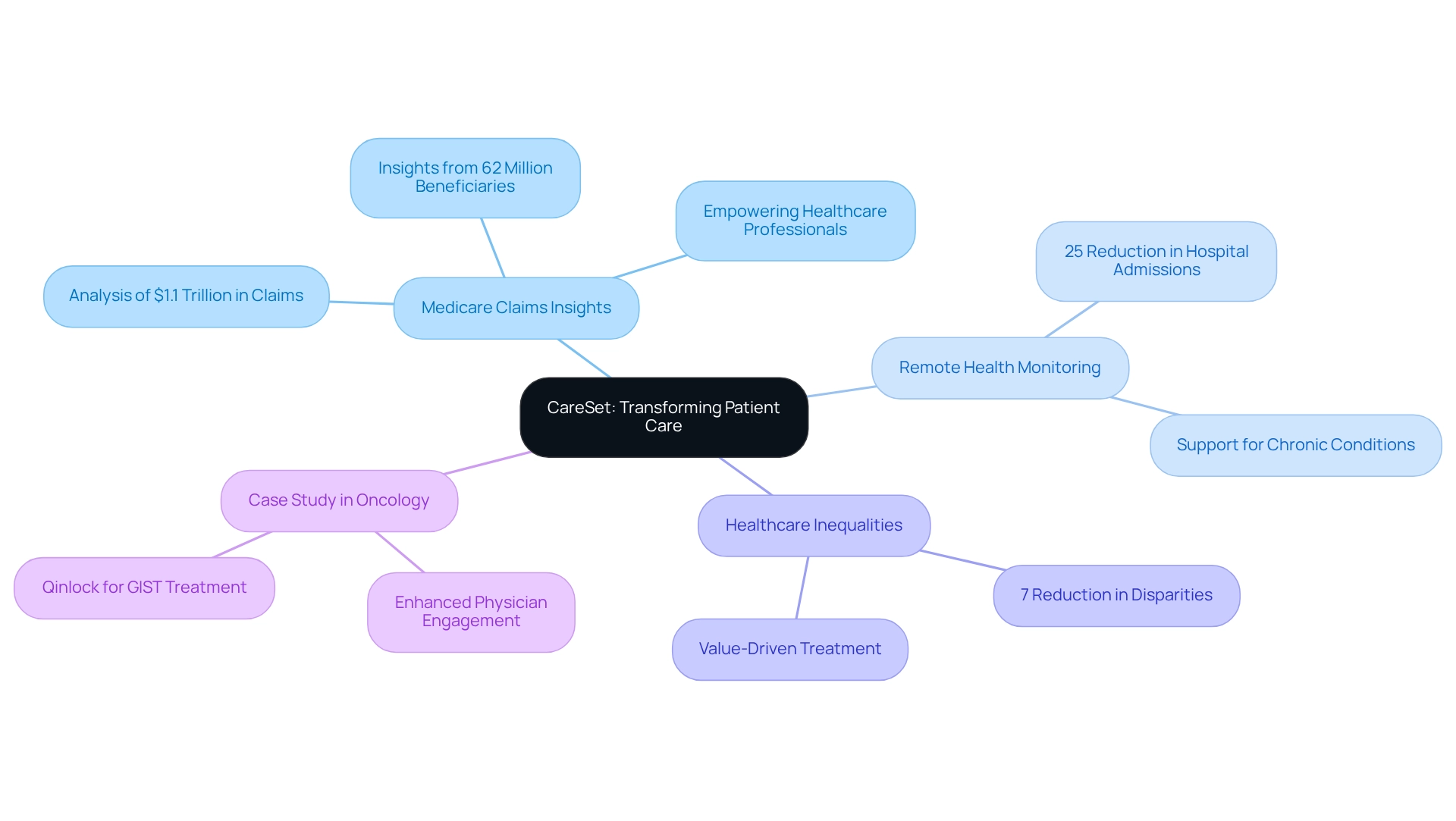
Florida Department of Health: Pioneering Quality Improvement Initiatives in Nursing
The Florida Department of Health has launched a series of initiatives that serve as an example of quality improvement in nursing, designed to advance nursing practices across the state. These initiatives prioritize client safety, aim to reduce hospital readmissions, and ensure that nursing staff are equipped with the latest best practices. By fostering a culture of ongoing enhancement, the department has become an example of quality improvement in nursing, significantly elevating the service provided by nursing professionals and resulting in improved outcomes for those receiving treatment. Recent efforts have concentrated on applying evidence-based practices that conform to national safety standards, showcasing a commitment to excellence in healthcare.
For instance, similar initiatives in other healthcare settings, such as DaVita dialysis clinics, have served as an example of quality improvement in nursing by improving referral processes, enabling more individuals to secure kidney transplants, thereby underscoring the tangible benefits of quality improvement efforts. One successful initiative involved incorporating principles focused on individuals, reflecting the belief of Francis Peabody, who emphasized that genuine healing encompasses addressing the individual’s overall well-being beyond mere medical treatment. This holistic approach has been pivotal in enhancing the care experience, reinforcing the notion that genuine attention is essential for effective healing.
Expert insights from nursing leaders within the Florida Department of Health underscore the importance of quality service, clinical excellence, and member satisfaction. As highlighted by the Blue Care Network of Michigan, their 2022 program specifically targets these elements, which are critical in cultivating a safe and inclusive healthcare environment.
Moreover, the impact of nursing best practices on safety has been significant, with evidence indicating that adherence to these practices correlates with improved outcomes for individuals. The Military Health System, serving 9.6 million beneficiaries, emphasizes the necessity of high-quality care and safety for individuals, reinforcing the importance of the Florida Department of Health’s initiatives. The department’s ongoing commitment to excellence not only addresses current healthcare challenges but also lays the groundwork for long-term progress in nursing practices throughout Florida.
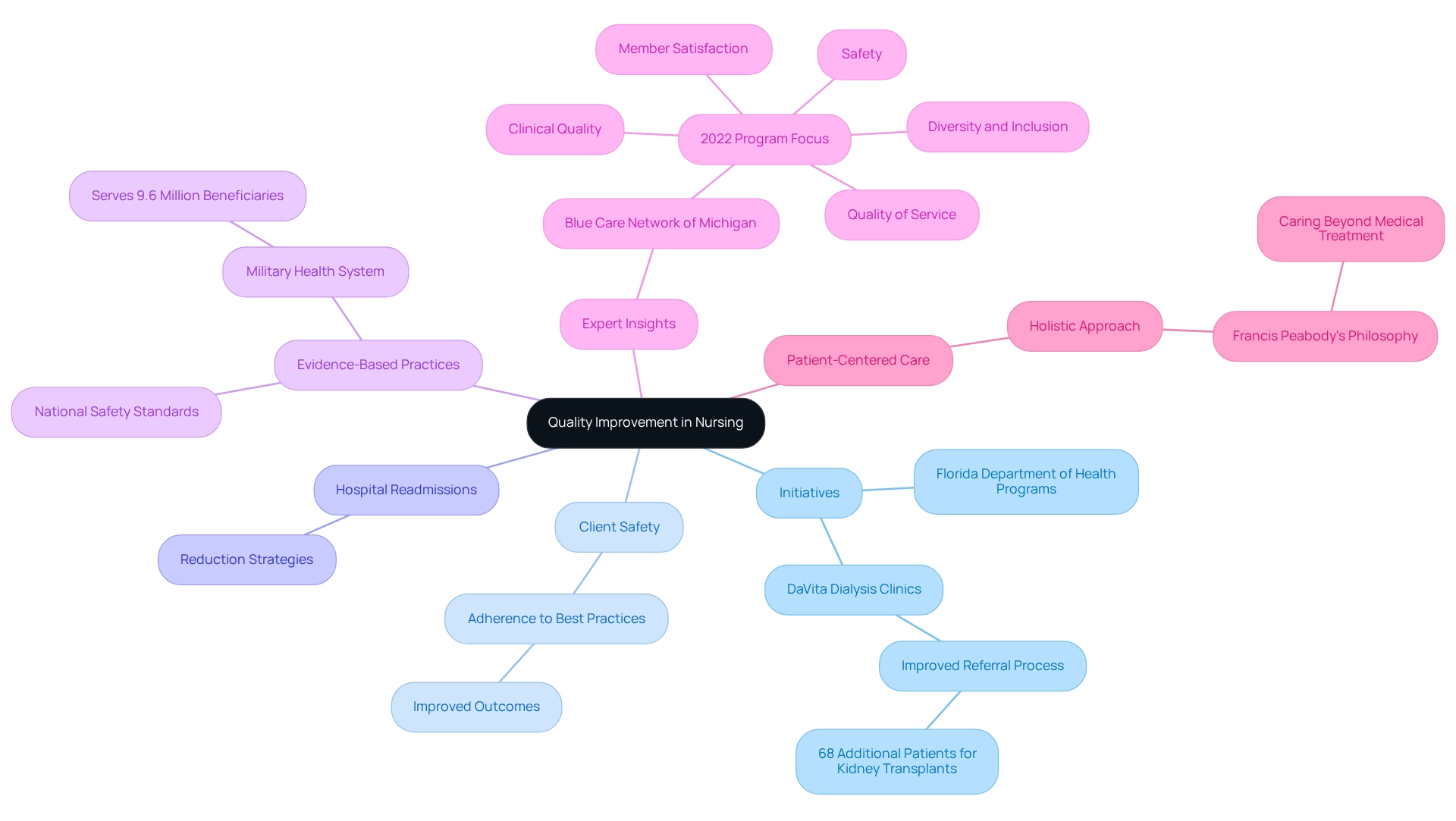
Joseph Brant Hospital: Enhancing Patient Safety through Quality Improvement Projects
Joseph Brant Hospital has launched several quality enhancement projects that are an example of quality improvement in nursing, aimed at improving safety for individuals, particularly through the establishment of standardized protocols for medication administration. These protocols are meticulously designed to mitigate the risk of medication errors, which significantly contribute to patient harm; indeed, medical errors account for approximately 30% of injuries related to prescribed medications in hospital settings. A recent study underscores this issue, stating, “Medical errors contribute to 30% of injuries resulting from prescribed medications within hospital environments.” Additionally, the hospital has instituted regular safety audits, which are crucial in identifying potential gaps in care delivery.
Joseph Brant Hospital has reported a notable reduction in medication errors and adverse events, serving as an example of quality improvement in nursing by actively engaging staff in these initiatives. This organized approach to quality enhancement is an example of quality improvement in nursing, demonstrating the effectiveness of these efforts and underscoring the hospital’s commitment to fostering a culture of safety. Recent initiatives have shown that hospitals employing stringent safety evaluations and standardized procedures can serve as an example of quality improvement in nursing, achieving significant improvements in care outcomes and reinforcing the notion that true healing necessitates a genuine concern for the individual’s well-being beyond mere medical treatment.
Furthermore, CareSet’s case study titled “Putting Individuals First: Unlocking Medicare Data to Empower HCP” illustrates how data transparency and comprehensive insights can enhance safety and outcomes. By leveraging such data-driven approaches, healthcare organizations can implement similar enhancement initiatives, ultimately leading to improved treatment and more substantial interactions with healthcare providers regarding options.

L.A. Care Health Plan: Innovative Strategies for Quality Improvement in Nursing
L.A. Care Health Plan has pioneered innovative strategies that are an example of quality improvement in nursing and client support. A pivotal component of these initiatives is the integration of telehealth services, which has markedly improved client engagement. Notably, statistics indicate that the adoption of telemedicine surged from 15.4% in 2019 to an impressive 86.5% in 2021, underscoring its escalating significance in healthcare delivery.
Furthermore, L.A. Care has developed extensive training programs focused on cultural competency for nursing personnel, ensuring that support is tailored to the diverse needs of individuals. These concerted efforts have led to substantial advancements in client satisfaction and health outcomes, illuminating the transformative potential of innovation in healthcare.
According to Blue Care Network of Michigan, “enhancement strategies are vital for offering members affordable, innovative offerings that enhance their health and well-being.”
Case studies further underscore the effectiveness of telehealth services, revealing that only 0.2% of telehealth providers were flagged as potentially high-risk for fraud, thereby reinforcing the credibility of telehealth as a safe and compliant choice for individuals.
Through these strategic initiatives, L.A. Care Health Plan stands as an example of quality improvement in nursing, showcasing how innovative approaches can drive enhancements and ultimately improve outcomes for those receiving treatment.
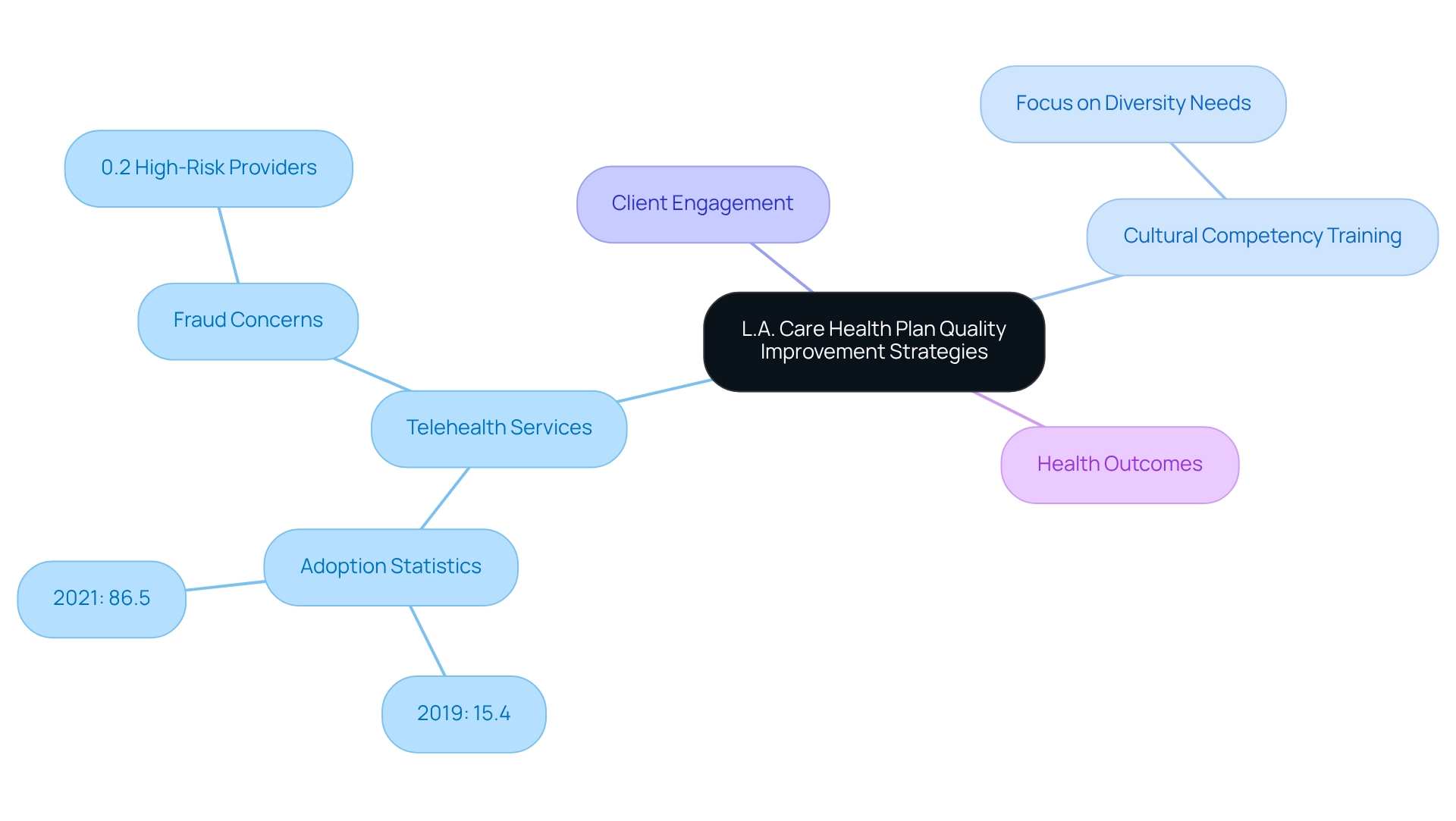
Blue Care Network of Michigan: Best Practices in Patient Engagement and Quality Improvement
The Blue Care Network of Michigan has pioneered best practices in client engagement, which serves as an example of quality improvement in nursing and plays a crucial role in enhancing nursing quality. Central to these practices are customized treatment plans designed to meet individual needs and preferences. This method not only fosters a cooperative atmosphere but also actively involves individuals in their treatment choices. As a result, the network has observed significant improvements in individual compliance with treatment protocols, with compliance rates markedly increasing due to the tailored support approach.
Regular follow-ups have been established to sustain engagement, ensuring individuals feel supported throughout their healthcare journey. These initiatives have led to greater overall satisfaction with services, demonstrating the substantial impact of personalized treatment plans on both individual outcomes and nursing standards, which serves as an example of quality improvement in nursing.
Looking ahead to 2025, statistics suggest that effective strategies for engaging individuals, like those employed by the Blue Care Network, are vital for improving treatment adherence and enhancing the overall quality of nursing services. Notably, 29% of participants in a national sample reported feeling they lacked essential information necessary to understand the suggested treatments, underscoring the importance of personalized care plans in enhancing understanding and engagement. Furthermore, the Updox database contains engagement information for 150 million individuals, emphasizing the scale and impact of effective engagement practices.
CareSet’s commitment to data leadership and its extensive Medicare insights, derived from over 62 million beneficiaries and 6 million providers, further illustrate how high-quality data can improve health outcomes and nursing quality. By leveraging insights from ICD, NDC, and HCPCS codes, CareSet empowers healthcare strategies that guide individuals through their treatment pathways, ensuring that providers can effectively manage support from diagnosis to treatment.
As Theodore Roosevelt aptly stated, ‘No matter how skilled a healthcare professional is, the individual’s perception of care often hinges on the compassion and understanding they receive.’ This highlights the emotional aspect of engagement and the critical role of personalized care plans in fostering empathy.
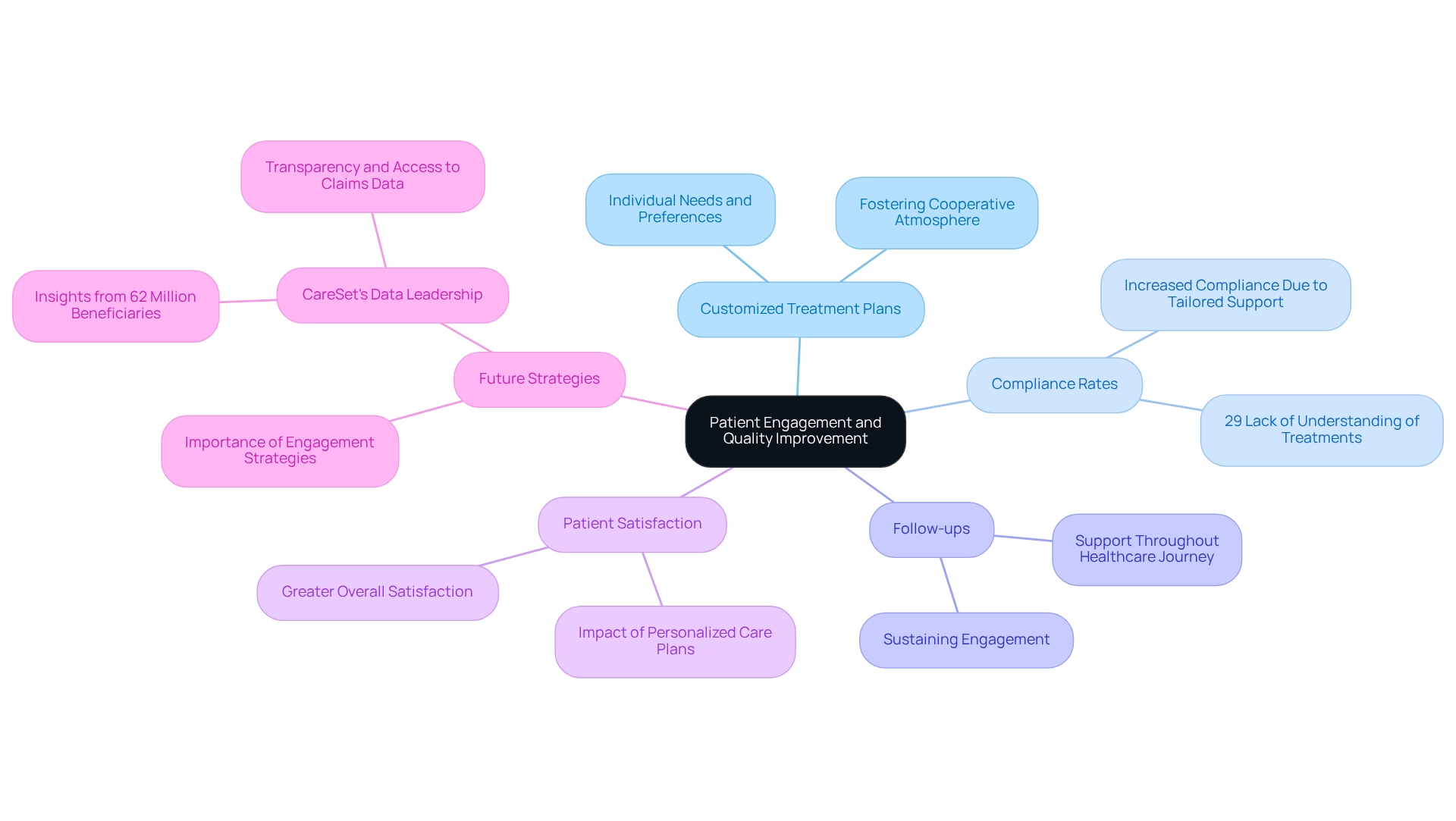
Beth Israel Medical Center: Leveraging Technology for Quality Improvement in Nursing
Beth Israel Medical Center has effectively harnessed technology to elevate nursing standards. The implementation of electronic health records (EHR) and mobile health applications has notably streamlined communication among healthcare providers, enhancing the accessibility of individual data. These advancements are an example of quality improvement in nursing, fostering more efficient workflows and empowering nurses to make better-informed clinical decisions.
As a result, healthcare service standards have significantly improved, with research indicating that EHR adoption correlates with higher revenues and reimbursements, despite initial productivity declines. Furthermore, insights from experts at Beth Israel Medical Center underline that these technological innovations not only enhance operational efficiency but also promote a culture of continuous improvement in service delivery.
It is essential to recognize, however, the obstacles to EHR adoption that many facilities encounter, which can impede the full realization of these benefits. A testimonial from one of our clients highlights the positive impact of these technologies:
‘Increased physician efficiency and streamlined workflows led to 10% cost savings in administrative overhead.’
This underscores the tangible benefits that EHR systems can provide as an example of quality improvement in nursing standards and patient care.
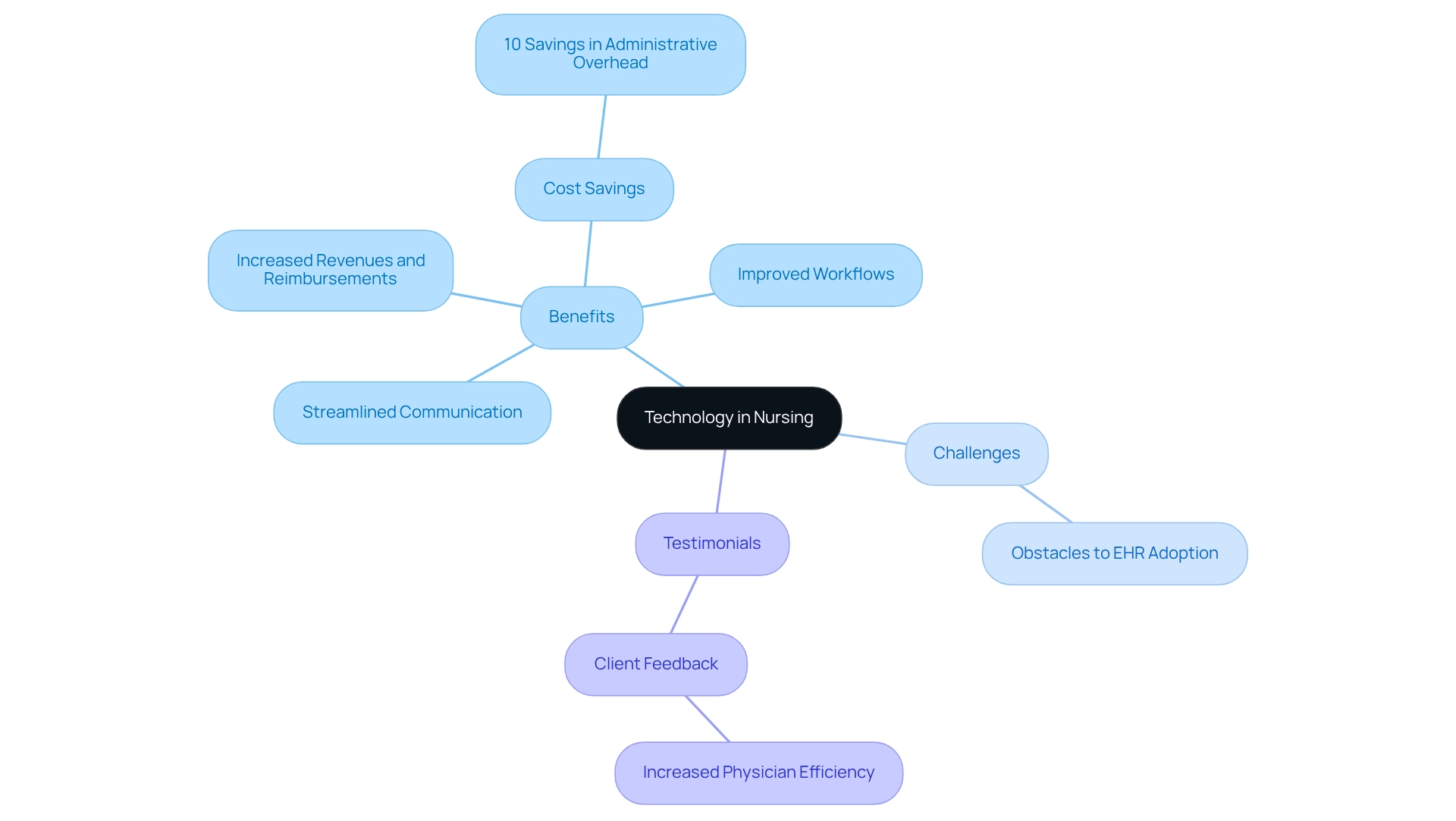
Mount Sinai: Integrating Patient Feedback into Quality Improvement Initiatives
Mount Sinai has adeptly integrated feedback from individuals into its enhancement initiatives, recognizing it as essential for the advancement of healthcare delivery. Through regular client satisfaction surveys and focus groups, the hospital collects invaluable insights that shape its quality enhancement strategies. This proactive approach serves as an example of quality improvement in nursing, resulting in significant enhancements in service delivery and care protocols, ensuring that voices are not only acknowledged but also acted upon.
By 2025, the impact of these initiatives is evident; hospitals prioritizing client feedback report elevated Net Promoter Scores and increased satisfaction levels. Notably, similar initiatives at DaVita led to a more effective referral system, enabling 68 additional individuals to receive kidney transplants, underscoring the tangible benefits of enhancement efforts.
By fostering a culture of empathy and proactive care—critical components in healthcare—Mount Sinai serves as an example of quality improvement in nursing, demonstrating how client feedback can drive substantial improvements in healthcare outcomes. This commitment to data excellence mirrors CareSet’s dedication to delivering superior Medicare insights, emphasizing the significance of comprehensive Medicare data solutions in empowering healthcare strategies and enhancing care for individuals.
CareSet’s insights, derived from over 62 million beneficiaries and 6 million providers, offer a robust foundation for healthcare stakeholders to make informed decisions, ultimately resulting in improved patient outcomes and business success.
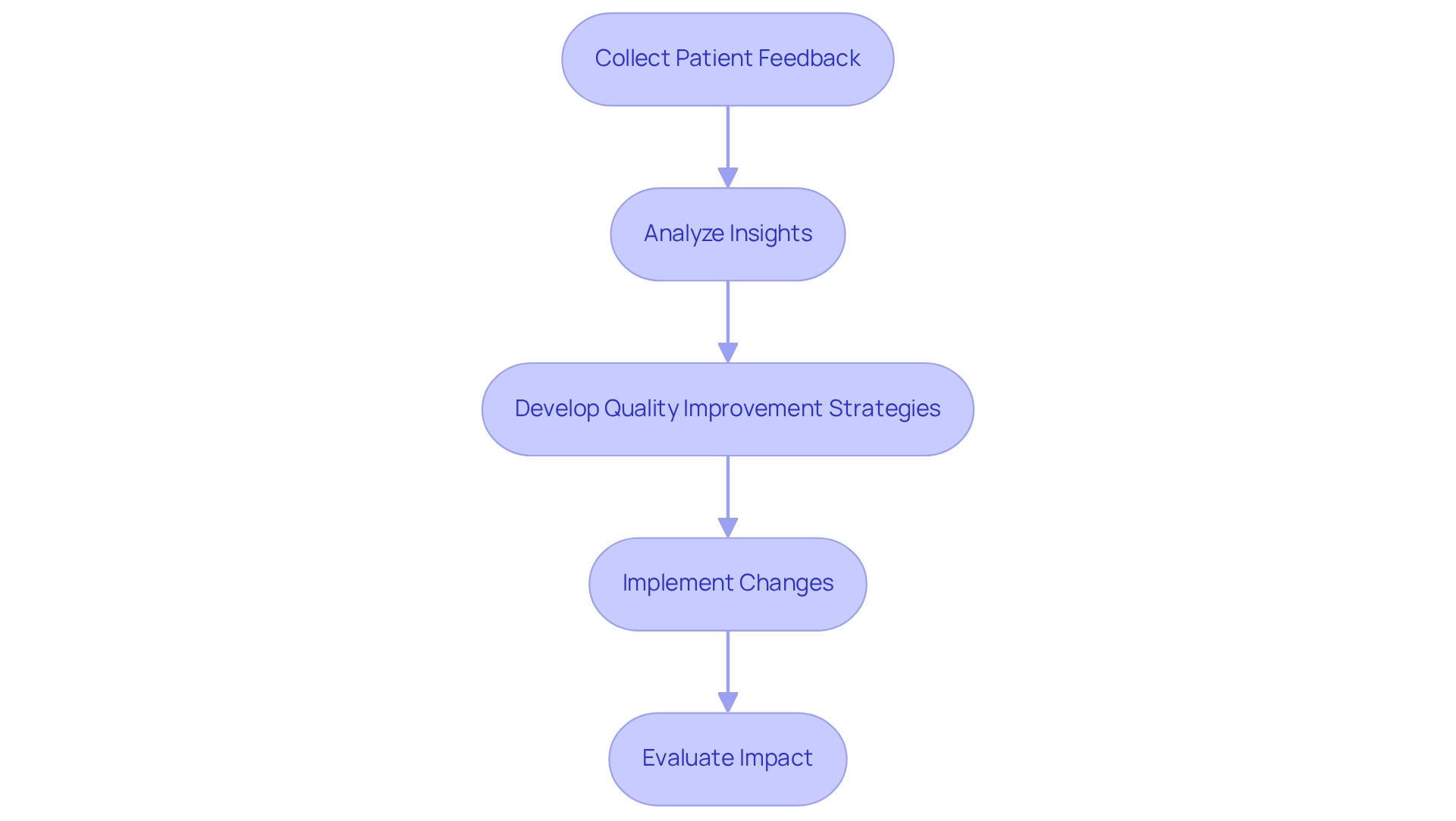
UC San Diego Health: Interdisciplinary Collaboration for Quality Improvement in Nursing
UC San Diego Health has established interdisciplinary collaboration as an example of quality improvement in nursing initiatives. By fostering collaboration among nurses, doctors, and allied health specialists, the organization has significantly enhanced communication and coordination of services. This collaborative framework has led to improved outcomes for individuals, evidenced by a remarkable increase in adherence discussions, which were previously addressed in only 7% of interactions.
Furthermore, case studies reveal that hospitals focusing on specific individual needs—such as transportation and follow-up appointments—exhibit variability in treatment priorities, ultimately influencing overall management strategies. As Erin P Finley, PhD, MPH, notes, “Effective interdisciplinary collaboration is crucial for enhancing outcomes and ensuring thorough care delivery.”
Additionally, analyses conducted with R, version 3.6.3, bolster these findings, underscoring the technical rigor behind the enhancement initiatives. The emphasis on cultivating a more assured clientele can also facilitate recovery and improve the Net Promoter Score, highlighting the broader impacts of these initiatives on customer satisfaction.
Therefore, UC San Diego Health is an example of quality improvement in nursing, illustrating how efficient collaboration can elevate nursing standards and healthcare delivery, resulting in enhanced service for individuals in 2025 and beyond.
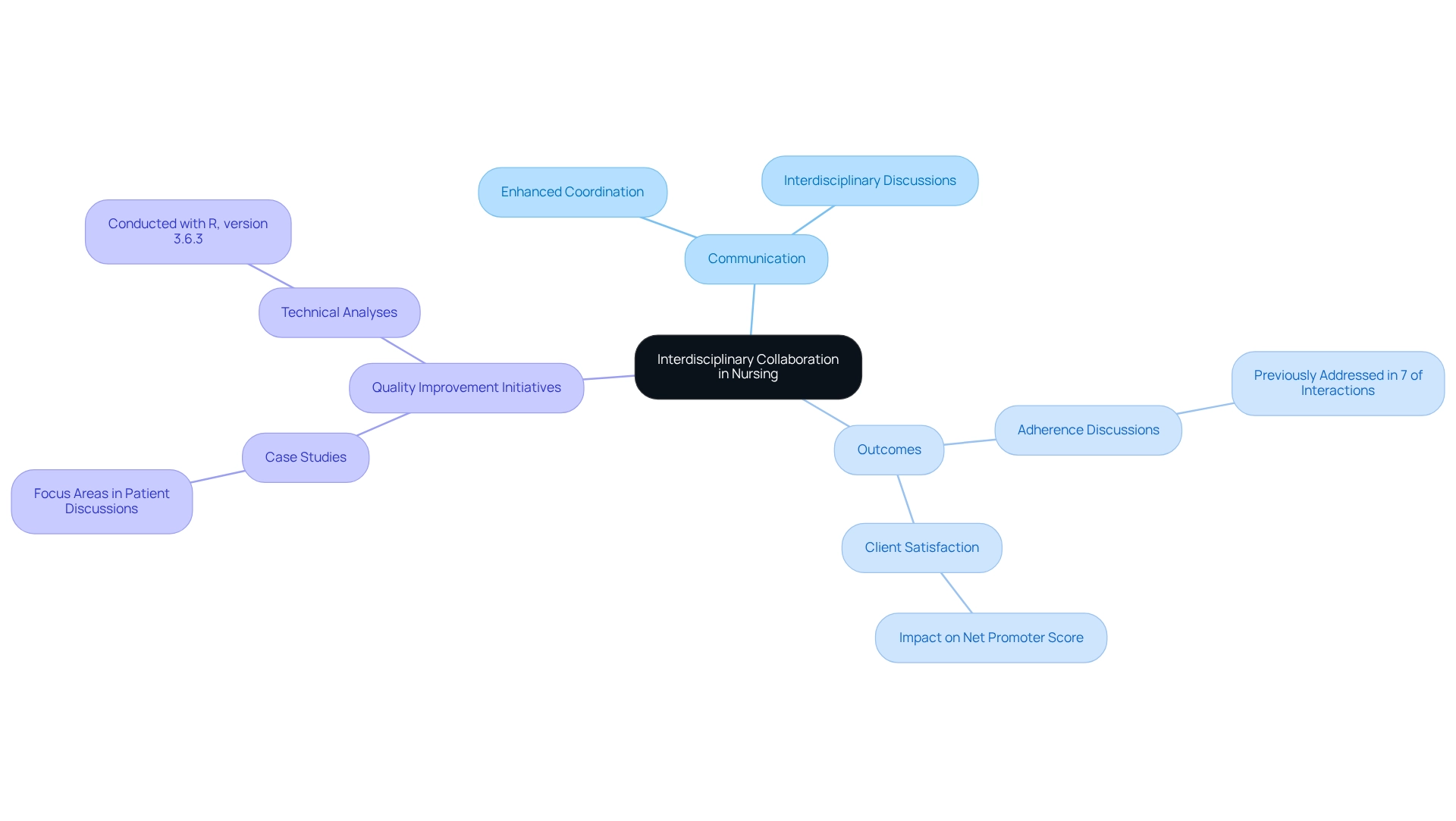
DaVita Dialysis Clinics: Targeted Quality Improvement for Specialized Patient Care
DaVita Dialysis Clinics have initiated targeted enhancement efforts designed to improve services for individuals with chronic kidney disease (CKD). An example of quality improvement in nursing is found at the heart of these initiatives, which are personalized care plans tailored to the specific needs of dialysis patients, complemented by regular monitoring of outcomes to ensure optimal treatment efficacy. As we look ahead to 2025, statistics indicate that common barriers to enhancing quality—such as resistance to change, lack of resources, data limitations, and time constraints—are being effectively addressed through these strategic efforts.
A notable case study underscores the success of DaVita’s kidney transplant referral enhancement project in Poland. Procedural adjustments allowed an additional 68 individuals to receive transplants by optimizing the timing of referral calls. This outcome exemplifies the critical role of targeted interventions as an example of quality improvement in nursing that advances healthcare. Moreover, expert insights reveal that personalized care plans significantly benefit CKD individuals, resulting in improved health outcomes and heightened satisfaction. The integration of advanced software technology has also played a vital role in these enhancement programs, facilitating streamlined data management and informed decision-making. By prioritizing customized enhancement efforts, DaVita demonstrates the effectiveness of strategic initiatives in addressing the unique challenges faced by dialysis patients, ultimately fostering better health management and engagement.

Oregon Health & Science University School of Nursing: Preparing Future Nurses through Quality Improvement Projects
Oregon Health & Science University School of Nursing is dedicated to cultivating the next generation of nurses through a robust curriculum enriched by enhancement projects. These initiatives are an example of quality improvement in nursing, providing students with invaluable practical learning experiences and underscoring the critical importance of exceptional service and safety for individuals. By equipping students with the essential skills to implement effective enhancement strategies, the school serves as an example of quality improvement in nursing, improving educational outcomes and fostering a workforce committed to advancing healthcare standards. This approach is crucial in tackling the evolving challenges within the healthcare landscape, ensuring that graduates are thoroughly prepared to contribute positively to patient care and safety.
According to the ‘120 Healthcare & Nursing Statistics for 2024,’ the complexities of the healthcare sector necessitate a solid foundation in excellence enhancement for nursing students. Furthermore, a case study titled ‘Economic Factors Affecting Nursing Careers’ highlights how financial considerations influence job satisfaction and retention rates among nurses, which serves as an example of quality improvement in nursing by emphasizing the importance of improvement initiatives in enhancing career longevity and satisfaction.
As Mikhail Shneyder, president and CEO of Nightingale College, articulates, “Although your educational journey may be difficult at times, you will reap the reward of utmost satisfaction when holding your nursing diploma for the first time—and nothing will ever compare to the fulfillment that improving and saving the lives of others will bring!” This sentiment aligns seamlessly with the mission of Oregon Health & Science University, as it serves as an example of quality improvement in nursing by preparing its students to meet the demands of the healthcare sector while prioritizing quality care and patient safety.
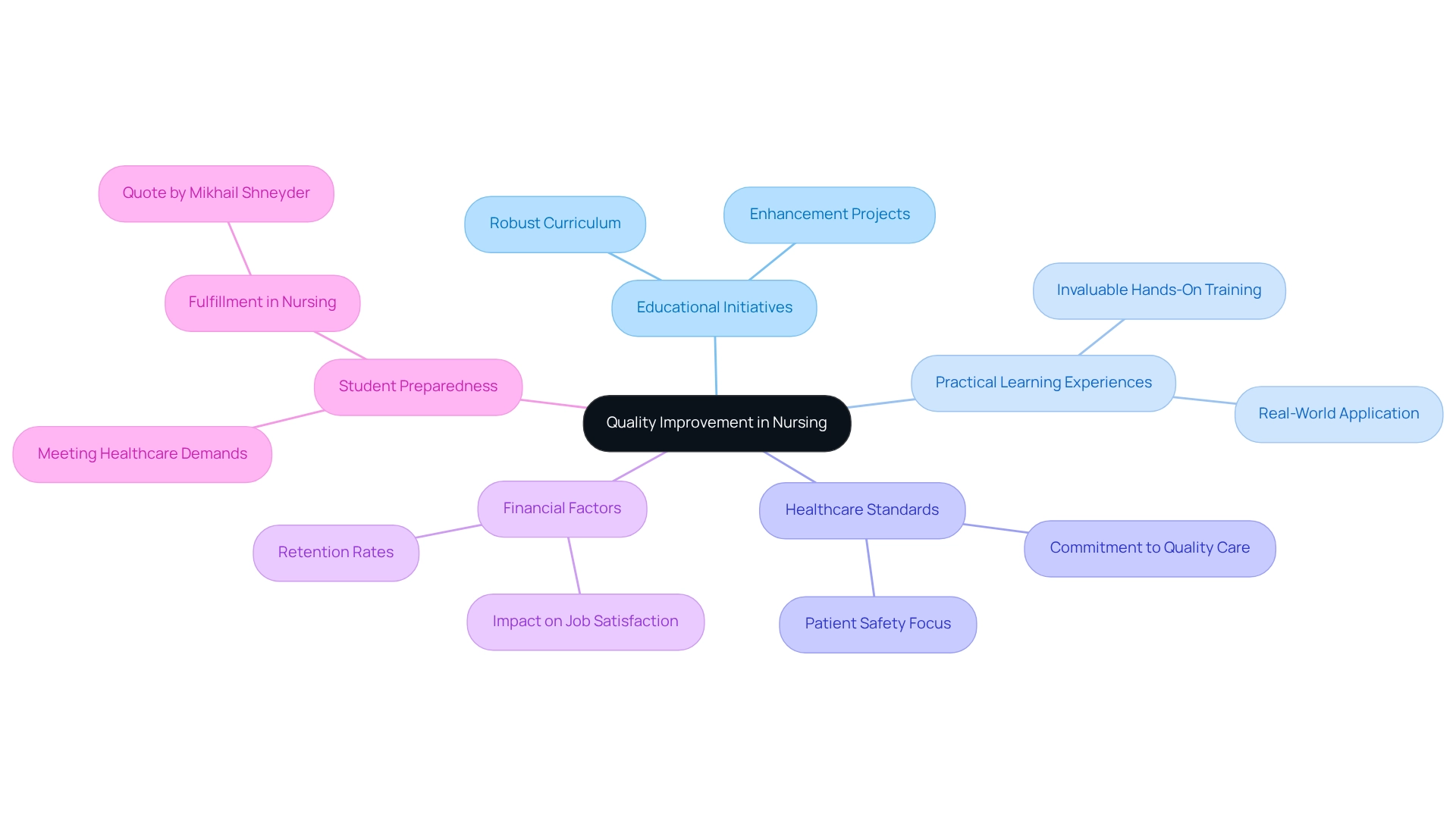
Conclusion
The transformative initiatives highlighted throughout the healthcare landscape underscore a shared commitment to quality improvement and patient-centered care. CareSet’s utilization of comprehensive Medicare data exemplifies how data-driven insights can empower healthcare providers to enhance treatment decisions, ultimately leading to better patient outcomes. By addressing critical gaps in care and fostering transparency, CareSet is paving the way for equitable healthcare delivery.
Similarly, the Florida Department of Health and Joseph Brant Hospital have demonstrated the profound impact of quality improvement projects on nursing practices and patient safety. By prioritizing evidence-based approaches and standardized protocols, these organizations have significantly reduced hospital readmissions and medication errors, reinforcing the importance of a culture of safety and continuous improvement in healthcare settings.
Moreover, innovative strategies employed by organizations like L.A. Care Health Plan and Mount Sinai emphasize the role of technology and patient feedback in driving quality enhancements. The integration of telehealth services and personalized care plans not only improves patient engagement but also fosters a collaborative environment that enhances treatment adherence and satisfaction.
As the healthcare industry continues to evolve, the commitment to quality improvement initiatives remains paramount. By leveraging interdisciplinary collaboration, technology, and patient insights, healthcare organizations are not only addressing current challenges but also laying a robust foundation for future advancements. The collective efforts of these entities highlight a hopeful trajectory towards a healthcare system where patient safety, satisfaction, and quality of care are at the forefront, ensuring a brighter future for all stakeholders involved.


